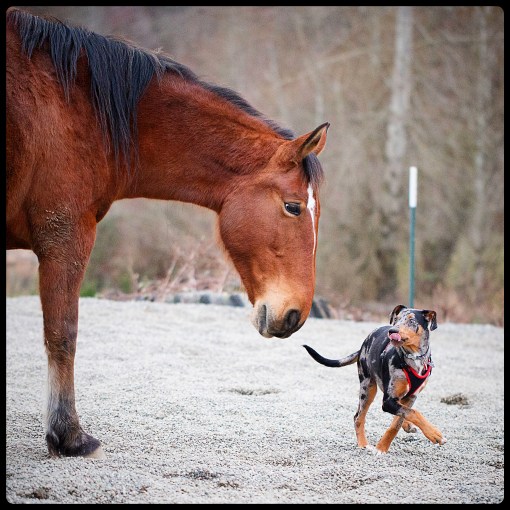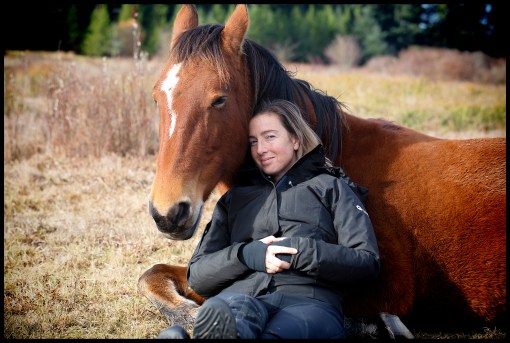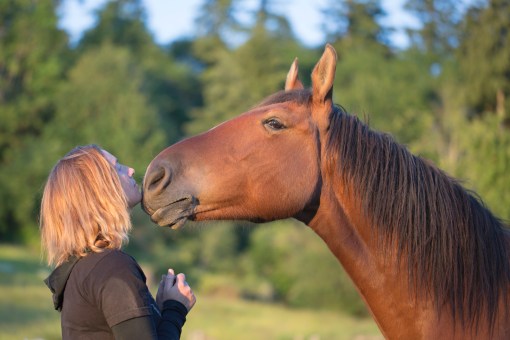The Project:
Mustangs directly off the range, One Trainer, Many Students, Communication through body language, Tools used only for safety, never to train.

The Goal:
To discover how far Equestrian Art can be developed solely using body language.
It’s all in the Timing
I just returned from a teaching trip to San Diego and then Costa Rica, and yes, the joke could be that my timing was perfect to escape the abnormally frigid temperatures that hit the Pacific Northwest during those two weeks. Thank you a million times over to my dearest friends who stayed home and took care of all my animals through the cold. I really didn’t time it this way on purpose; this particular timing was just lucky.
What is interesting though is how much of my trip was about honing and developing timing as a conversational tool with horses.
It is said in horse training that the hardest things to teach are feel and timing. So what have I done? It seems I have made that my mission in life, to teach the un-teachable and to train what is most difficult to train. There are a million brilliant horse trainers who might help you with everything else, and everything you learn with horses will lead you to some understanding of feel and timing because the interesting fact is, all those training methods are only as good as your personal feel and timing as you apply them.
Feel and timing are often considered sort of magical qualities that one has or does not have. That may be to some extent true, however, I also believe if you don’t have them yet, they are very learnable skills.
What Freedom Based Training does is slow everything down to a natural horse’s voluntary speed of conversation.

Conversation with a horse is made up of movements, and when we slow those movements down we can really start to see, hone and develop our timing and feel.
Feel is knowing where and how to be around a horse to direct the conversation to what you had in mind.
Timing is knowing when to move and when to be still. Timing is knowing when to harmonize with the horse and when to let your movements be in a counterpoint or in disharmony with them.
This is what I teach.
This is what I am perpetually learning more about!
The thing that I really was able to focus on deeply on this trip was in looking at the three different versions of conversation we tend to have with a horse.
In San Diego (Bonsall), at Horse Spirit Ranch I was given the most wonderful diverse set of students and horses to work with. Everyone seemed fascinated with Freedom Based Training from beautifully unique points of view. Every time I get to walk in someone else’s footsteps for a moment and see things from their point of view, I see this work in new light.

When we talk with a horse on the passive scale, it is slow, it is quiet and I believe this is the majority of what normal conversations are between horses who live together in a natural calm environment. On the passive scale of communication, connection is not readily apparent, it is instead build deeply, gently and so gradually you almost can’t see it happening. `
When we talk with a horse on the assertive scale, it is about asking for things – they ask us, we ask them, and it is a back and forth discussion of movements. Assertive is the middle ground between Passive and Dominant and leads to a more quickly apparent connection between conversationalists.
When we talk with a horse on the dominant scale, it is about asking for things and setting a consequence if we don’t get what we asked for. This is the scale most people are familiar with in horse training. It is also the most obvious connection-building and potentially the quickest.
Now just to be clear here, the dominant scale does include R+ training. If I have all the cookies, the horse knows that and wants them. Then when I ask for some movement, the consequence for the horse not performing the movement is they don’t get the reward. It may be a kind and positive way of training, but it is still dominant, and based on consequences associated with resource guarding.
So if you are in conversation with a horse and there are consequences set when movements are not made as asked, congratulations, you are on the fastest track to feeling connected with your horse. You are also on the most challenging path in terms of feel and timing. Do you have it?
Having feel and timing when you are talking with a horse on the dominant scale is important, because if you are even the littlest bit off on your feel or timing, your horse will set consequences for you. They will push on you, they will startle you, they will intimidate you. When you see the bottom of both hind feet in the air in front of our face, yes, they might be playing, but they are playing a Dominance game in which that threat of a kick in your direction is telling you your feel and timing of movements are off, and the ball is in your court. Do you then set a counter-consequence for them? Or do you switch to a different scale of communication?

It all depends on what your goals are. If your goal is to feel as connected to your horse as possible, as soon as possible, then playing the game of consequences with them with good feel and timing is the way to go.
If your goal is more like mine, to develop better feel and timing while taking the slow and deeply profound road to connection, take a step down on the intensity scale and develop your passive conversation. You will never regret the things you learn in the slower passive conversation, even if you choose to step back up to the dominant scale at some later date.
What I teach in Freedom Based Training is about Passive and Assertive leadership, simply because Dominant leadership usually requires tools. As human beings we lack the strength and power to dominate well without a tool to help us.
I have found that a horse developed through Passive leadership is usually fairly kind and gentle as you struggle through your learning process of feel and timing. Even if you get it wrong, your horse tends to tell you gently.
When you work with a horse accustomed to conversation on the dominant scale, you may find they set harsh consequences for you when you get your feel or timing wrong.
I don’t know about you, but I know I want a horse that is going to fill in for me a little when I am having an off day. I want a horse who is going to be kind and gentle with me as they help me develop better feel and timing.

Here is where this blog gets interesting, because in the second part of my trip I got to step into the student role for a little while, unlike my normal way of working with horses.
I was invited to the Leaves and Lizards Retreat in the Arenal region of Costa Rica. If you ever get a chance to go, do! The jungle experience is phenomenal and the retreat is breathtakingly beautiful.
While I was there I put on a very well-received screening of Taming Wild for mostly Costa Rican locals. (Thank-you to all of you who helped me get the Spanish subtitles done in time.) And I was able to help with an up-and-coming documentary about the connections between horses and humans. Check out the trailer for the film “Sans Attache”; it looks like it is going to be beautiful! Thank you Audrey Pages for inviting me to come up and interview with you for the film. I felt honored to be included in the project.
On a side note, I was invited to show some of what I do with Freedom Based Training while exchanging ideas with Debbie Legg and Sally Nilsson about the similarities and differences in the EFL work they do at Leaves and Lizards.

Now this is really interesting to me, because I believe as a professional in the horse world it is best if I keep learning and stretching myself, stepping outside of what I know and being open to learning new things. If you have any interest in EFL work with horses, I think Sally and Debbie do a brilliant job of it and I would encourage you to take a trip there and experience one of their workshops for yourself.
In the EFL work we did together I was encouraged to work with the horses and look for their feedback, using them as a mirror to see my own emotional blocks and hindrances to communication both in the moment and in the rippling ramifications through my life outside that moment. Really interesting work and truly a whole blog of its own for another time. It is deep and powerful for those interested in personal development.

What spoke to me most though was again this issue of timing. When do we move, and when do we choose to be still, and how does that affect the direction of our relationship? Why do we make the choices we make, and what are the pros and cons of any choice?
In EFL work, if a horse pins their ears at you, that is information that can point to a place to stop and talk about. What was the feeling you had in that moment – was it the emotion in you hidden under the surface that the horse was pinning his ears at? EFL is about delving into that information and learning from it. I found this fascinating and different from what I do.
Freedom Based Training on the other hand is about learning the timing. How do we on a very physical level learn where to step, where to stand, how to ask so that we don’t get pinned ears? In Freedom Based Training I would never choose to stop on the note of a horse pinning their ears at me because I am aiming for harmony in the relationship.
The places we pause reinforce the last thing that happened between us.
In Freedom Based Training I am perpetually looking to hone the timing and find pauses on harmony and positive feedback from my horse.

In Freedom Based Training I encourage my horses to train me with positive feed back, yes, do more of that – that feel and timing was right. Those are the moments we pause and rest. When negative feedback happens from my horse we just keep moving through it. I hear them express that I got my feel and my timing wrong (or perhaps from an EFL point of view my emotion and energy was off) but we do not dwell on it. We keep moving past it to something better.
I want to believe that the powerful learning and work we can do in EFL is somehow combinative with what I do with Freedom Based Training, but for now I have to admit, I don’t know enough to know if it can be combined well. It will absolutely be something I consider more as I move forward through this work.
From Leaves and Lizards I moved on to do a week’s workshop with Discovery Horse Tours near Playa Hermosa, Costa Rica.- stunningly beautiful and a very different jungle from what we had experienced up in the Arenal area.
I have to say Discovery Horse Tours set up the workshop with a brilliant ease and comfort in everything we did. I also have never met horses so open and interested in the passive leadership conversations as this herd was. Wow they were fun to work with!
We started with a demo where I walked through the beginning steps of the foundations in Passive Leadership conversation, and then one at a time each horse seemed to be waiting at the gate for their turn to give this new conversation style a go with their person for the week.

Session after session after session I was blown away by how fully these horses were interested and engaged in it all.
I don’t know if this was a group of students with particularly good feel and timing, or if it was that the horses were particularly open to the ideas of downshifting from the more normal dominant spectrum of conversation to a passive one. I have a feeling it was a healthy dose of both which came together for a spectacular week.
Day one everyone worked one on one with their horses in the round pen, and then in the afternoon we rode through the fields and jungle to the waterfall to play.

Day two we all worked together with the horses as a herd in the pasture, building on the first day’s conversations. In the afternoon we left the horses to play with each other and headed out on the river to watch incredible feel and timing between Costa Rican men and a few special crocodiles they had befriended over the years.
Day three we took off from the horses and hiked through incredible jungle with hanging bridges and the sort of waterfalls you think only exist in fairy tales.

Day four we did an intensive day’s work with the horses, the morning spent working one pair at a time in the round pen (again the horses seemed so eager each one of them for their turn) and then the afternoon out in the pasture with all the herd together honing the skills learned in the morning.

Day five we completed our week of Freedom Based Training work and I believe we left everyone wanting more, as I like to do.

Day six we started with a zip-line tour through the jungle, and then, once everyone had spent their adrenaline reserves, we headed back to the horses for a long and beautiful exploratory ride through the jungle.

A huge gratitude to Andrea Wady for setting up this workshop so smoothly and for inviting me to come teach! I am sure this is just the beginning of more Costa Rica fun to be had I am sure in years to come. Definitely keep Discovery Horse Tours in mind if you are ever in the area, or simply escaping the northern chill like I was. You will be entranced.
As for me, I am happily home again pondering the merits of various types of conversation with horses, getting ready to finish up my winter online course session with some amazing students, while also in conversation with new students I can’t wait to know better as we gear up for the spring Freedom Based Training online course.
As all this comes together and I revel in my own continued learning with my horses, there are great plans on the horizon for an amazing teaching tour in May, and a few fun destinations for workshops and screenings before and after. All the dates are up on the website with links to where you can get more information.
I look forward to so many great conversations ahead in 2017. Passive, Assertive, and Dominant – there is a time and place for everything and I am fascinated with every variation.
Hooves and Heartbeats,
Elsa
TamingWild.com




































































